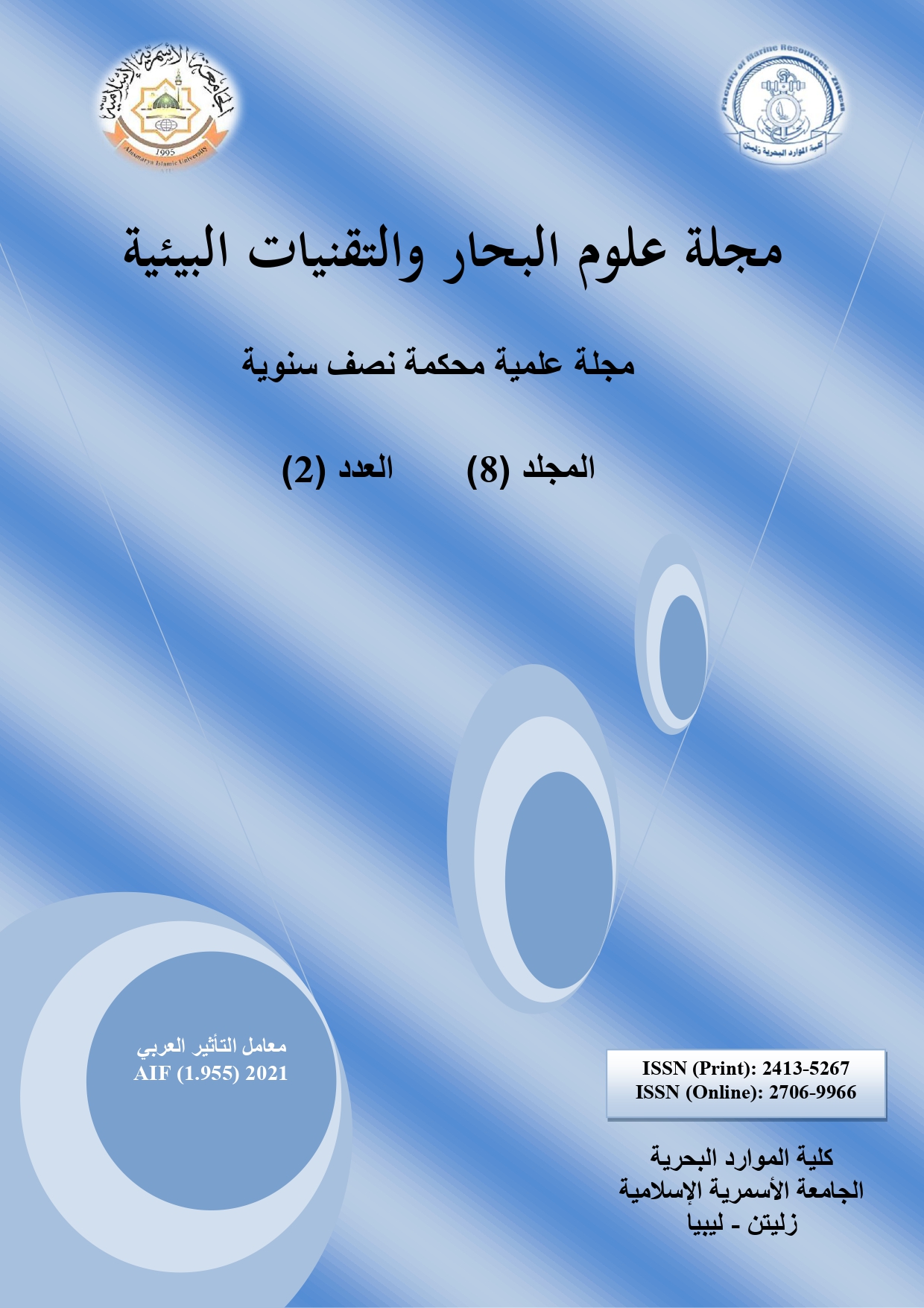محاكاة انبعاث وتشتت الملوثات الغازية المنبعثة من محطة توليد الطاقة والتأثيرات البيئية المحتملة: دراسة حالة
DOI:
https://doi.org/10.59743/jmset.v8i2.64الكلمات المفتاحية:
أسبن هايسيس، ديسبر، الانتشار، الانبعاث، محطة الكهرباء، خوارزمية WARالملخص
تم تقدير مستويات التدفق والانبعاثات الغازية الملوثة المنبعثة من محطة توليد الزاوية المزدوجة (ZCPP) في شمال ليبيا باستخدام برنامج المحاكاة Aspen-Hysys v.8.0 والتي تم إجراؤها للمحطة بناءً على ظروف التشغيل الفعلية لمحطة توليد الطاقة في حالة تشغيل مستقرة. ثم تم استخدام برنامج نمذجة تشتت الهواء برنامج (Disper V4.0) لتقدير تركيز هذه الملوثات المنبعثة في جميع أنحاء المناطق المحيطة، كما تم استخدام خوارزمية WAR v.1.0.17 للتحقق من الآثار البيئية المحتملة لانبعاثات الغازات من المحطة. أظهرت نتائج المحاكاة لوحدة الطاقة المدروسة أن الكفاءة الحرارية وصافي الطاقة الخارجة متكافئتان مع القيم الواقعية للمحطة، مما يشير إلى أن تركيز الانبعاث المقدرة مطابقة للانبعاثات الحقيقية من هذه المحطة وأن الملوث الرئيسي المنبعث هو أكاسيد النيتروجين، والذي تجاوزت قيمه الحدود المعيارية الدولية المختارة. وبناءً على الظروف المناخية الموسمية للمنطقة، أظهرت نتائج محاكاة تشتت أكاسيد النيتروجين أن الانبعاثات تصل إلى مناطق بعيدة عن مصدر الانبعاث بتراكيز عالية المستوى والتي قد يكون لها آثار سلبية على البيئة والصحة العامة وفقًا لمعايير منظمة الصحة العالمية والدراسات السابقة المتعلقة بجودة الهواء. ووفقًا للأدبيات العلمية الحالية، تؤكد نتائج قيم المؤشرات الثمانية المستمدة من WAR لمعدل الإنتاج الإجمالي للتأثيرات البيئية المحتملة للعملية في الساعة على أنها ضارة بالبيئة. علاوة على ذلك، فإن كمية ثاني أكسيد الكربون المنبعثة من عملية الاحتراق تزيد من ظاهرة الاحتباس الحراري. تشير نتائج الدراسة أن الهواء الجوي للمنطقة المحيطة بمدينة الزاوية ملوث بأكاسيد النيتروجين الناتجة عن محطة توليد الكهرباء قيد الدراسة والتي تعتبر أحد المصادر الرئيسة لأكاسيد النيتروجين في منطقة الدراسة مما قد يكون له تأثير سلبي على البيئة وصحة السكان القاطنين بها.
التنزيلات
المراجع
Afifi F.A. (2000). Dynamics of toxins and environmental pollutants and response to the respiratory system and periodic, 1st edition. Dar Al-Fajr Publishing and printing, Libya. [In Arabic]
AHGU (2016). Aspen-Hysys v8.0 Guide User's. Aspen Technology Inc., Bedford, Massachusetts, USA.
Al-Awadhi M.M. & Yassin M.F. (2010). Evaluating the impacts of SO2 emissions from power stations in Kuwait. WIT Trans. Ecol. Environ., 136: 59-70.
Al-Azmi B.N., Nassehi V., & Khan A.R. (2008). Impact of emissions from power stations on the ambient air quality of selected urban areas in Kuwait. Atmos. Environ. Sci, 4: 558-568.
Al-Satuf A.A. (1995). Environmental Pollution (Sources-Effects-Protection Methods), 1st ed., Sebha University publications, Libya. [In Arabic]
Cabezas H., Bare J.C., & Mallick S.K. (1997). Pollution prevention with chemical process simulators: the generalized waste reduction (WAR) algorithm. Computers & Chemical Engineering, 21: S305-S310.
Cabezas H., Bare J.C., & Mallick S.K. (1999). Pollution prevention with chemical process simulators: the generalized waste reduction (WAR) algorithm—full version. Computers & Chemical Engineering, 23(4-5): 623-634.
Dopatka J., Ford N., & Jiajanpong K. (2003). Opportunities to Achieve Improved WFGD Performance and Economics. Proceedings of the Combined Power Plant Control Mega Symposium, Washington, D.C.
DUG (2007). Users guide for Disper v.4.0. Canarina Algoritmos Numéricos, S.L., Spain. Available online at: [https://disper.software.informer.com/4.0/].
EG “Egyptian law” (2005). Ministerial Resolution No. 1741 of 2005, Executive Annexes to Law No. 4 of 1994 Concerning the Environment, Egypt.
EU (2005). Preparation of the review relating to the Large Combustion Plant Directive. A Report for European Commission, Environment Directorate General, Entec UK Limited, England.
Fellah G. & Noba K.B. (2016). Thermodynamic Analysis of Zawia Combined Cycle Power Plant. Int. J. Eng. Pa., 1: 74–81.
Garg A., Bhattacharya S., Shukla R.P., and Dadhwal K.V. (2001). Regional and Sectoral Assessment of Greenhouse Gas Emissions in India. Atmospheric Environment, 35(15): 2679-2695.
GECOL “General Electricity Company of Libya”. (2014). GECOL database for 2012. Available online at: [www.gecol.ly].
Gillani N.V., Meagher J.F., Valente R.J., Imhoff R.E., Tanner R.L., & Luria, M. (1998). Relative Production of Ozone and Nitrates in Urban and Rural Power Plant Plumes, 1. Composite Results Based on Data from 10 Field Measurement Days. J. of Geophysical Res., 103(D17): 22593-22615.
Gokhale S. & Khare M. (2004). A review of deterministic, stochastic and hybrid vehicular exhaust emission models. Int. J. Transport Manage., 2(2): 59-74.
Hart B.R., Powell M.A. Fyfe W.S., & Ratanasthien B. (1995). Geochemistry and Mineralogy of Fly-Ash from the Mae Moh Lignite Deposit, Thailand. Energy Sources, 17(1): 23-40.
Ibrahim H.G., Okasha A.Y., Elatrash M.S., & Al-Meshragi M.A. (2012)a. Computer Assessment of SO2 and NOx Emitted from Khoms Power Station in Northwestern Libya. Int. J. Modern Eng. Sci., 1(1): 45-54.
Ibrahim H.G., Okasha A.Y., Elatrash M.S., & Al-Meshragi M.A. (2012)b. Emissions of SO2, NOx and PMs from cement plant in vicinity of Khoms city in North Western Libya. Journal of Environmental Science and Engineering A, 1: 620-628.
Islas J., Manzini F., & Martínez M. (2002). Renewable energies in electricity generation for reduction of greenhouse gases in Mexico 2025. AMBIO: A Journal of the Human Environment, 31(1): 35-39.
Kouprianov V.I. (2002). Influence of Lignite Quality on Airborne Emissions from Power Generation in the Russian Far East and in Northern Thailand. J. Fuel Process. Tech., 76(3): 187-199.
Krupnick A.J. and Burtraw D. (1996). The Social Cost of Electricity: Do the Numbers Add Up? Resources for the Future Discussion Paper 96-30, Washington, D.C.
KSA (2003). General Presidency of Meteorology and Environment Protection. Measures to protect the environment. Document No. (1409-01). Ministry of Defense and Aviation, Kingdom of Saudi Arabia.
Levy J.I., Hammitt J.K., Yanagisawa Y., & Spengler J.D. (1999). Development of a New Damage Function Model for Power Plants: Methodology and Applications. Environmental Science and Technology, 33: 4364-4372.
LY (2008). The environmental requirements for the protection of air pollution. Decision of the Secretary of the Administrative Committee of the General Authority for the Environment No. (96), Triploi, Libya.
Mallick S.K., Cabezas H., Bare J.C., & Sikdar S.K. (1996). A pollution reduction methodology for chemical process simulators. Industrial Engineering and Chemistry Research, 35(11): 4128-4138.
MCGO (2016). Reported data for natural gas specifications. Milletah Company for Oil and Gas, Libya
Meteorological data (2017). Meteorological data for Zawia zone. Available online at: [https://www.windfinder.com]
NAAQS (2008). National Ambient Air quality standards. U.S. Environmental Protection Agency.
Nicholas P.C. (2002). Handbook of Air Pollution Prevention and control. Butterworth-Heinemann, Elsevier Science.
Okasha A.Y., Hadia E.A., & Elatrash, M. S. (2013). Ecological Effect of Mergheb Cement Emissions on the Vegetation in the Northwest Libya. International Journal of Sciences, 2(9): 34–40.
ORNL “Oak Ridge National Laboratory and Resources for the Future” (1994). Estimating Fuel Cycle Externalities: Analytical Methods and Issue. McGraw-Hill, Utility Data Institute, Washington, D.C.
Roots O. (2008). Materials corrosion and air pollution Long-term studies at the Lahemaa monitoring station, Estonia. Proceedings of the Estonian Academy of Sciences, 57(2): 107–116.
Rowe R.D., Lang C.M., Chestnut L.G., Latimer D.A., Rae D.A., Bernow S.M., & White, D.E. (1995). The New York Electricity Externality Study, Vol. I: Introduction and Methods. Empire State Electric Energy Research Corporation, New York.
Ryerson T.B., Buhr M.P., Frost G.J., Goldan P.D., Holloway J.S., Hubler G., Jobson B.T., Kuster W.C., McKeen S.A., Parrish D.D., Roberts J.M., Sueper D.T., Trainer M., Smith K.R., Samet J.M., Romieu I., and Bruce N. (2000). Indoor Air Pollution in Developing Countries and Acute Lower Respiratory Infections in Children. J. Thorax, 55: 518-532.
Sahu S.K., Zhu S., Guo H., Chen K., Liu S., Xing J., Kota, S. & Zhang H. (2021). Contributions of power generation to air pollution and associated health risks in India: Current status and control scenarios. Journal of Cleaner Production, 288: 125587.
USEPA (2010). Standards of Performance for Stationary Combustion Turbines. Final Rule. Environmental Protection Agency, Federal Register, Vol. 71, No. 129, Thursday, July 6, 2006, Rules and Regulations, USA.
WHO (2005). Air Quality Guidelines for Particulate Matter, Ozone, Nitrogen Dioxide and Sulfur Dioxide. Global Update 2005. Geneva: World Health Organization. Available online at: [http://whqlibdoc.who.int/hq/2006/WHO_SDE_PHE_OEH_06.02_eng.pdf]
ZCPP “Zawia Combined Power Plant” (2016). Reported Data. GECOL, Tripoli, Libya.
التنزيلات
منشور
إصدار
القسم
الرخصة
الحقوق الفكرية (c) 2022 مجلة علوم البحار والتقنيات البيئية

هذا العمل مرخص بموجب Creative Commons Attribution 4.0 International License.












